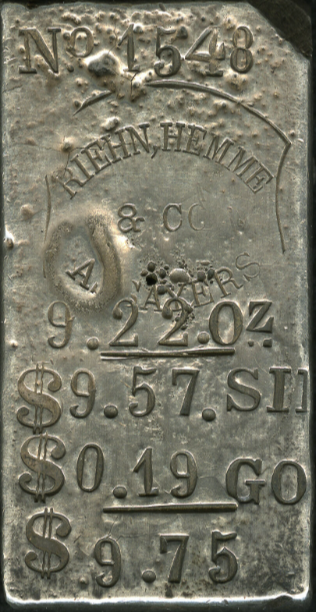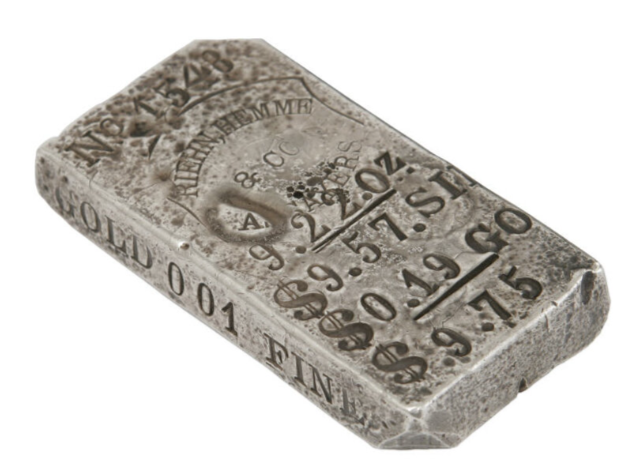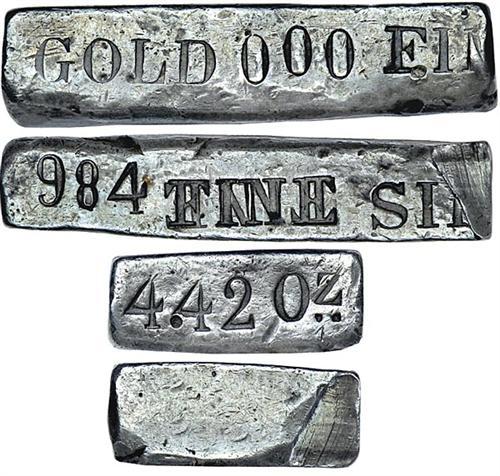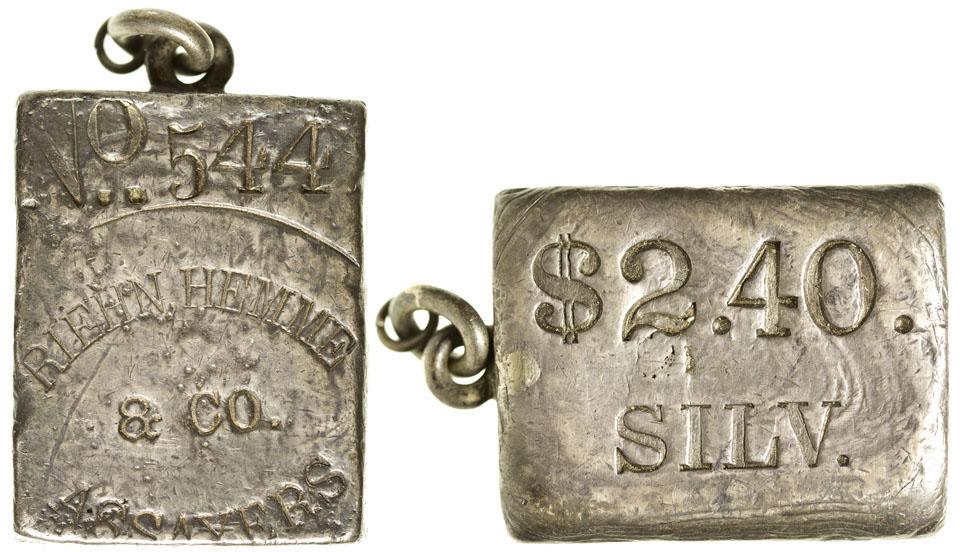Charles F. Riehn and August Hemme opened an assaying business in late 1862 or early 1863. The company had an office in the heart of the San Francisco financial district at 432 Montgomery near the corner of Montgomery and California, directly across the street from the Wells, Fargo & Co.’s bank and express office.
Prominent gold rush assayers Henry Hentsch and Francis Berton also had an office in the same building as Riehn and Hemme, possibly across the hall, but moved out within the next year. Riehn & Hemme’s lab and processing facilities were located at 408 Montgomery and 1 Sumner Street. By the end of the Civil War in 1865, Riehne & Hemme were one of a dozen assaying firms in San Francisco.
Riehn & Hemme’s business was right in the middle of the mining sector of the business section of San Francisco. The building directly across the street at 422 Montgomery housed no fewer than a half dozen mining stock brokers. Orville Ames, and three others, ran a mining stock brokerage next door. Charles Sutro, Adolph’s brother, ran a gold dust and bullion brokerage business located immediately across the street from Riehn & Hemme. Kellogg & Hewston, perhaps the best known California gold rush assay firm of the period, was located just a few doors down the street at 416 Montgomery.
In the early 1870s, Riehn & Hemme centralized their business to the 404 Montgomery location, where they stayed for another decade, until selling out to F. Reichling about early 1882. The two decades they were in business was a long stretch for any California assay firm.
The San Francisco assaying firm of Riehn, Hemme & Co. was small and, judging from its failure to buy display ads in city directories and its failure with the Daegener bar, not very successful. Information about the firm is sparse. In 1862 Charles F. Riehn was the foreman in the Assay Department of the San Francisco Mint. He lived at 11 Stockton Street. August Hemme was born in Hannover, Germany in 1834. He made more money in real estate than in assaying, and by 1870 was worth $55,000. In the 1952 Historical Sketch of Oakland we read the following about Mr. Hemme: “August Hemme has by far the finest farm in Contra Costa County, situated in the heart of the San Ramon Valley, extending from hill to hill, and comprising about 2,000 acres. Standing out in bold relief is the mansion, the architectural proportions and symmetry of which are the pride of the citizens of Contra Costa. It is supplied with all modern conveniences, and an abundance of fine spring water. Gas is manufactured on the premises. The yard is filled with choice fruit trees and ornamental trees, yielding to their owner, who planted them, a generous return of fruit and shade. There are four orchards on this place, producing fine crops of choice apples, pears, plums and other fruits. Wheat is the chief production of which large crops are raised; this land and valley is noted for its superior wheat.
On the place are about 175 head of choice breeds of cattle, 20 extra large mules, and other stock required on such a farm. Hanover, Germany, is the birth place of August Hemme. Into this old and aristocratic capital of Northern Germany he made his advent in 1833. At the age of eleven he emigrated to the United States. The first five years of his residence was upon the Atlantic slope. In 1849 he took up his line of march the second time for a new home, and finally pitched his tent on the banks of the Feather River, California. Here he plied the rocker and the sluice with flattering results until, yielding to the longings for broad acres and cultivated fields, he pre-empted a portion of his present farm in 1852, and resided there until 1863, when he sold, and removed to San Francisco. Having greatly prospered, he purchased the old home farm, and has added several hundred acres to it, and made it now one of the large and productive farms of the State. Mr. Hemme resides in San Francisco in an elegant residence, on the corner of Franklin and Washington streets, near which he has erected several other fine houses. His chief vocation for years has been that of an assayer. But while he analyzes ores and refines bullion, we find him with one eye at least shrewdly criticizing the stock market, a field in which few have been more successful than he. Quiet in his operations, he moves in the arena of stocks unostentatiously, and usually with marked success, as his large acquisitions testify. His beneficiaries here are princely, as is evidenced by an entire church constructed by his liberality. The Central Presbyterian Tabernacle in San Francisco, including furniture and library, and costing $150,000, is a lasting monument to his faith and works. Other generous gifts of thousands to public and private charities, churches and schools, are unknown to the general public. Thus fur Mr. Hemme has fulfilled a grand mission-one that curries with it memories fragrant as morning flowers, and as enduring as the immortal.” Hemme died in 1904.
The Riehn, Hemme & Co. firm is listed at the corner of Montgomery and California Streets in 1864-64, 408 Montgomery Street in 1865, and 432 Montgomery Street in 1866. In 1867-8 the company name changed to associate Mark McDonald with the firm. By 1870, McDonald’s name hud been dropped and the firm was then located at 404 Montgomery Street. In 1865 the company assayed ores from the White Diamond Ledge mine (Mount Diablol owned by the Open Sesame Company. Stack’s thanks noted western antiquarian John J. Ford, Jr. and well known author Dan Owens, for their help with the directory search and historical data given.
9.22 oz Riehn, Hemme Assayers, San Francisco, Silver Ingot, ca. 1862-1882.



This rectangular ingot shows irregularities from the silver pour and cooling, as usual. The topside reads: No 1548 / RIEHN, HEMME / & CO / ASSAYERS / 9.22. Oz / $9.57. SIL / $0.19 GO / $9.75. One of the long sides reads: SILV. 803 FINE. The other long side reads: GOLD 001 FINE. The back of the ingot has an indistinct revenue stamp.
From The Alan Bingel Collection.
[01/2002] https://archive.org/details/americanacolonia2002stac/page/56/
Silver ingot made by the San Francisco, California assaying firm of Riehn, Hemme & Co., undated (after June 30, 1864, probably before 1867). No. 1548. $9.75. 9.22 ozs. Gold $0.19. Silver $9.57. 68.6×35.4×12. 1mm. rectangular in appearance, trapezoidal in cross-section. Essentially, as made, a few light marks acquired over the years, one dig on right edge.
- Front: No. 1548 [preceding by individual punches] RIEHN, HEMME 7 CO ASSAYORS within shield shaped outline [preceding in logotype] 9.22.0z. $9.57.SIL $0.19 GO $9.75 [preceding in individual punches].
- Left Edge: GOLD 001 FINE.
- Right Edge: SILV. 803 FINE.
- Top Edge: blank. Bottom Edge: blank.
- Back: U.S. INTR REVENUE tax paid stamp in upper left comer.
- Upper right and lower left corners clipped for assay, as expected.
Neither marked. This Riehn, Hemme bar is a recent discovery, first showing up in a dealer’s hand in April, 2001. At the time of this writing, this is the only Riehn, Hemme & Co. Assayers bar known. This is its first auction appearance. We date the bar after June 30, 1864 by the presence of the Internal Revenue stamp on the back. In 1867 the firm’s name changed, providing us with the other end of the suggested dating. Interestingly, William Daegener’s correspondence, preserved in the California Historical Society, contains a letter from Riehn, Hemme & Co. to Daegener apologizing for a faulty assay returned as a bar and notifying him that they have credited his Wells, Fargo account with the $17 their assay was out. The letter mentions that the Daegener bar was numbered 8067.
[07/2005] https://coins.ha.com/itm/territorial-gold/riehn-hemme-assayers-san-francisco-silver-ingot-ca-1862-1882-charles-f-riehn-and-august-hemme-opened-an-assaying-busi/a/382-10478.s ($19,550)
4.42 oz Riehn, Hemme & Company. San Francisco, California. Silver assay ingot no. 808, $5.62 monetized


Overall appearance of Very Fine. Medium silver gray color. A fairly rough looking bar with somewhat rough surfaces, disfiguring button flaw in the center of the face (like the other bar known from this firm), and a deep cooling depression on the back. This is just one of two known Riehn, Hemme & Company ingots (not counting the watch fob).
The form of the Internal Revenue tax paid stamp on this bar is the one assumed to be earlier than the commoner round seal, here a plain tablet with the word TAX and the dollar amount of the tax payable on the bar. This form would have been used before the round stamps were shipped to assayers and seems to date bars so marked as made after September and probably before December, 1864. The apparent uniformity of this format across several different assayers in different locations suggests to the cataloguer that, rather than an ad hoc measure, this might have been according to Office of Internal Revenue requirements. Also interesting is the observation that the gold content given on this bar is 000 while on the other bar known from this firm it is 001.
The firm’s name on the bar was accomplished by a rather grand logotype that appears to be identical on both known Riehn, Hemme bars. This bar has had one corner clipped while the other one known (bar number 548 with the OIR stamp on the back) shows two opposing corners clipped. Mr. Ford’s informational card for this ingot bears the notation (in handwriting characteristic of his younger days) “Note corner cut off for assay?”, suggesting he wasn’t then sure that was why corners were cut from some bars after manufacture.
- Face: No.808 / RIEHN, HEMME / & [CO] / ASSAYERS / $5.62.
- Back: TAX $0.03.
- Top side: blank.
- Bottom side: 4.42 Oz.
- Left side: 984 FINE (doubled, first upside down) SIL[V.]
- Right side: GOLD 000 FIN[E].
- Dimensions: 50.3 x 26.1 x 9.5 mm.
- Current weight: 137.9 gms.
From the John J. Ford, Jr. Collection
Provenance: Noted as in the Kagin Collection on August 30, 1956 and December, 1957.
[10/2007] https://auctions.stacksbowers.com/lots/view/3-AV6P3/riehn-hemme-company-san-francisco-california-silver-assay-ingot-no-808 ($32,200)
Riehn Hemme & Co Silver Watch Fob Ingot No. 544, $2.4

- Obverse: No. 544 / Riehn, Hemme / & CO. / Assayers
- Reverse: $2.40. / SILV.
This is a very unique and attractive watch fob ingot – a form factor you don’t see very often, let alone tied to a specific assayer. It was dug from an outhouse site of a mining camp in Sierra County by the owner’s husband – what a find!
[06/2011] https://www.icollector.com/CA-San-Francisco-Riehn-Hemme-Silver-Watch-Fob-Ingot-No-544_i10678724 ($25,850)
